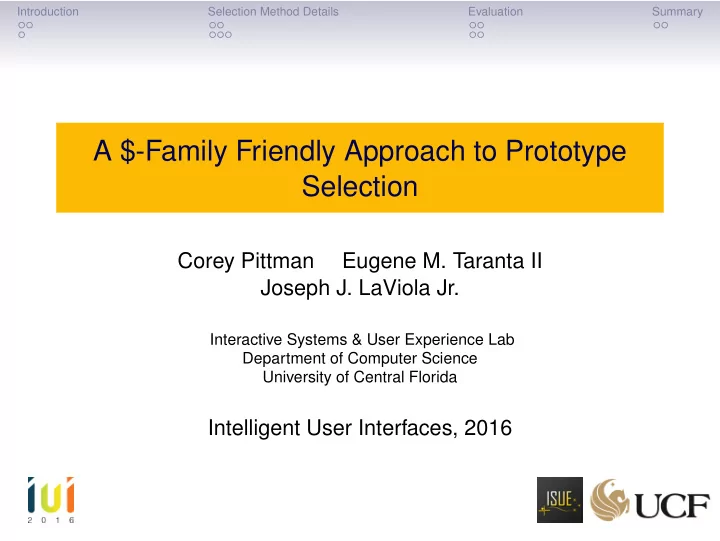

Introduction Selection Method Details Evaluation Summary A $-Family Friendly Approach to Prototype Selection Corey Pittman Eugene M. Taranta II Joseph J. LaViola Jr. Interactive Systems & User Experience Lab Department of Computer Science University of Central Florida Intelligent User Interfaces, 2016
Introduction Selection Method Details Evaluation Summary Background • Sketch gesture recognition continues to be a prominent feature in applications • $-Family recognizers ($1, $P , $N, 1¢) for gesture recognition • template matching (1-NN) • rapid prototyping • low coding overhead • error rates on par with state of the art • often use large datasets • Reducing computational overhead is beneficial for mobile devices
Introduction Selection Method Details Evaluation Summary Improving Performance • Execution time and memory usage scale linearly with size of dataset • Reducing size of dataset is simplest method for decreasing computational overhead
Introduction Selection Method Details Evaluation Summary Prototype Selection Methods • Naive method: Randomly select prototypes • Two proposed alternatives: • Genetic Algorithm (GA) • Random Mutation Hill Climb (RMHC) • More complex alternatives • K-medoids • Agglomerative Hierarchical Clustering
Introduction Selection Method Details Evaluation Summary Genetic Algorithms • Test the fitness of a population of candidate solutions • Each candidate solution is a set of prototypes which form a subset of the full dataset • Fit individuals generate subsequent generations via genetic operators • crossover to mix two candidates sets uniformly • mutation to change a single prototype in an individual • Iterate through generations of numerous solutions until an optimal fitness candidate is found
Introduction Selection Method Details Evaluation Summary Fitness Evaluation • A recognizer is constructed for each candidate solution • Each recognizer is tested on a random selection of samples from the dataset • The fitness of a candidate is the accuracy of its generated recognizer
Introduction Selection Method Details Evaluation Summary Random Mutation Hill Climb • Similar representation of candidate solution • Based on Skalak’s approach to prototype selection • Repeatedly mutate a single member of the subset for a predetermined number of iterations • Store highest fitness individual.
Introduction Selection Method Details Evaluation Summary Simple RMHC Example
Introduction Selection Method Details Evaluation Summary Actual RMHC Example $1-GDS from Wobbrock et. al. (2007)
Introduction Selection Method Details Evaluation Summary Design of Evaluation • Evaluated effect of selection methods on error rates for three recognizers: • Protractor • $N-Protractor • Penny Pincher • Three datasets were included in evaluation ($-GDS, SIGN, MMG) • Four selection methods were included (random, RMHC, GA, full dataset) • Each recognizer was tested with all datasets, selection methods, and per class template counts ( k = [ 1 , 5 ] )
Introduction Selection Method Details Evaluation Summary Procedure • Randomly generated tests by selecting a random subset to be recognized by candidate recognizers • Attempted to find optimal subset of prototypes to maximize recognition rate • Repeated test 500 times for each configuration
Introduction Selection Method Details Evaluation Summary Error Rates Reduced with Little Tradeoff GA $1-GDS GA MMG GA SIGN 120 % Reduction in Error Rate 100 80 60 40 20 0 RMHC $1-GDS RMHC MMG RMHC SIGN 120 % Reduction in Error Rate 100 80 60 40 Penny Pincher Protractor 20 $N-Protractor 0 1 2 3 4 5 1 2 3 4 5 1 2 3 4 5 Template Count Template Count Template Count
Introduction Selection Method Details Evaluation Summary Dramatic reduction in computation time and memory $1-GDS SIGN MMG Recognizer Mem Time Mem Time Mem Time Penny Pincher 98.3 95.7 99.7 99.5 97.5 95.2 Protractor 98.3 97.7 99.7 99.7 97.5 96.8 $N-Protractor 98.3 97.4 99.7 99.6 97.5 97.7 Percent reduction in memory consumption and runtime for k = 5 compared to baseline.
Introduction Selection Method Details Evaluation Summary Conclusion • While the results for the two methods are similar, we recommend RMHC. • straightforward to implement • mutation operator is exploratory component of GA • Optimizing the subset of samples can result in near baseline error rates • Selection methods serve as a preprocessing step to reduce spatial and temporal constraints
Introduction Selection Method Details Evaluation Summary Acknowledgments • NSF career award IIS-0845921 • ISUE lab members • Anonymous reviewers
Recommend
More recommend